
Hãy nhập câu hỏi của bạn vào đây, nếu là tài khoản VIP, bạn sẽ được ưu tiên trả lời.


e: \(\left\{{}\begin{matrix}\dfrac{1}{x}-\dfrac{1}{y}=1\\\dfrac{3}{x}+\dfrac{4}{y}=5\end{matrix}\right.\Leftrightarrow\left\{{}\begin{matrix}\dfrac{3}{x}-\dfrac{3}{y}=3\\\dfrac{3}{x}+\dfrac{4}{y}=5\end{matrix}\right.\)
\(\Leftrightarrow\left\{{}\begin{matrix}\dfrac{-7}{y}=-2\\\dfrac{1}{x}-\dfrac{1}{y}=1\end{matrix}\right.\Leftrightarrow\left\{{}\begin{matrix}y=\dfrac{7}{2}\\\dfrac{1}{x}=1+\dfrac{2}{7}=\dfrac{9}{7}\end{matrix}\right.\Leftrightarrow\left\{{}\begin{matrix}y=\dfrac{7}{2}\\x=\dfrac{7}{9}\end{matrix}\right.\)

c) \(\left\{{}\begin{matrix}2\left(x-2\right)+3\left(1+y\right)=2\\3\left(x-2\right)-2\left(1+y\right)=-3\end{matrix}\right.\)
\(\Leftrightarrow\left\{{}\begin{matrix}6\left(x-2\right)+9\left(1+y\right)=6\\6\left(x-2\right)-4\left(1+y\right)=-6\end{matrix}\right.\)
\(\Leftrightarrow\left\{{}\begin{matrix}13\left(1+y\right)=12\\2\left(x-2\right)+3\left(1+y\right)=2\end{matrix}\right.\)
\(\Leftrightarrow\left\{{}\begin{matrix}x=\dfrac{21}{13}\\y=-\dfrac{1}{13}\end{matrix}\right.\)
d) \(\left\{{}\begin{matrix}\left(x-5\right)\left(y-2\right)=\left(x+2\right)\left(y-1\right)\\\left(x-4\right)\left(y+7\right)=\left(x-3\right)\left(y+4\right)\end{matrix}\right.\)
\(\Leftrightarrow\left\{{}\begin{matrix}xy-2x-5y+10=xy-x+2y-2\\xy+7x-4y-28=xy+4x-3y-12\end{matrix}\right.\)
\(\Leftrightarrow\left\{{}\begin{matrix}-x-7y=-12\\3x-y=16\end{matrix}\right.\) \(\Leftrightarrow\left\{{}\begin{matrix}-x-7y=-12\\21x-7y=112\end{matrix}\right.\)
\(\Leftrightarrow\left\{{}\begin{matrix}22x=124\\3x-y=16\end{matrix}\right.\) \(\Leftrightarrow\left\{{}\begin{matrix}x=\dfrac{62}{11}\\y=\dfrac{10}{11}\end{matrix}\right.\)

\(\left\{{}\begin{matrix}\left(x-5\right)\left(y-2\right)=\left(x+2\right)\left(y-1\right)\\\left(x-4\right)\left(y+7\right)=\left(x-3\right)\left(y+4\right)\end{matrix}\right.\)
\(\Leftrightarrow\left\{{}\begin{matrix}xy-2x-5y+10=xy-x+2y-2\\xy+7x-4y-28=xy+4x-3y-12\end{matrix}\right.\)
\(\Leftrightarrow\left\{{}\begin{matrix}x+7y=12\\3x-y=16\end{matrix}\right.\) \(\Leftrightarrow\left\{{}\begin{matrix}3x+21y=36\\3x-y=16\end{matrix}\right.\)
\(\Leftrightarrow\left\{{}\begin{matrix}22y=20\\x+7y=12\end{matrix}\right.\) \(\Leftrightarrow\left\{{}\begin{matrix}x=\dfrac{62}{11}\\y=\dfrac{10}{11}\end{matrix}\right.\)

\(\left\{{}\begin{matrix}\dfrac{x+y}{5}=\dfrac{x-y}{3}\\\dfrac{x}{4}=\dfrac{y}{2}+1\end{matrix}\right.\)<=> \(\left\{{}\begin{matrix}3x+3y=5x-5y\\x=2y+4\end{matrix}\right.\)<=> \(\left\{{}\begin{matrix}2x-8y=0\\x-2y=4\end{matrix}\right.\)
<=> \(\left\{{}\begin{matrix}x-4y=0\\x-2y=4\end{matrix}\right.\)<=> \(\left\{{}\begin{matrix}y=2\\x=8\end{matrix}\right.\)

a: \(\left\{{}\begin{matrix}x+4y=-11\\5x-4y=1\end{matrix}\right.\Leftrightarrow\left\{{}\begin{matrix}6x=-10\\x+4y=-11\end{matrix}\right.\Leftrightarrow\left\{{}\begin{matrix}x=\dfrac{-5}{3}\\y=\dfrac{-11-x}{4}=\dfrac{-11+\dfrac{5}{3}}{4}=-\dfrac{7}{3}\end{matrix}\right.\)
b: \(\left\{{}\begin{matrix}2x-y=7\\3x+5y=-22\end{matrix}\right.\Leftrightarrow\left\{{}\begin{matrix}6x-3y=21\\6x+15y=-66\end{matrix}\right.\)
\(\Leftrightarrow\left\{{}\begin{matrix}-18y=78\\2x-y=7\end{matrix}\right.\Leftrightarrow\left\{{}\begin{matrix}y=\dfrac{-13}{3}\\x=\dfrac{y+7}{2}=\dfrac{4}{3}\end{matrix}\right.\)

\(a.\left\{{}\begin{matrix}\dfrac{1}{x}-\dfrac{1}{y}-2=-1\\\dfrac{4}{x}+\dfrac{3}{y}-2=5\end{matrix}\right.\)\(\Leftrightarrow\left\{{}\begin{matrix}a-b-2=-1\\4a+3b-2=5\end{matrix}\right.\) (với \(\dfrac{1}{x}=a-\dfrac{1}{y}=b\))
\(\Leftrightarrow\left\{{}\begin{matrix}a=\dfrac{10}{7}\\b=\dfrac{3}{7}\end{matrix}\right.\)\(\Leftrightarrow\left\{{}\begin{matrix}\dfrac{1}{x}=\dfrac{10}{7}\Rightarrow x=\dfrac{7}{10}\\\dfrac{1}{y}=\dfrac{3}{7}\Rightarrow y=\dfrac{7}{3}\end{matrix}\right.\)
\(b.\left\{{}\begin{matrix}\dfrac{2}{x}+\dfrac{5}{\left(x+y\right)}=2\\\dfrac{3}{x}+\dfrac{1}{\left(x+y\right)}=\dfrac{17}{10}\end{matrix}\right.\)\(\Leftrightarrow\left\{{}\begin{matrix}2a+5b=2\\3a+b=\dfrac{17}{10}\end{matrix}\right.\) (với \(\dfrac{1}{x}=a-\dfrac{1}{x+y}=b\))
\(\Leftrightarrow\left\{{}\begin{matrix}a=\dfrac{1}{2}\\b=\dfrac{1}{5}\end{matrix}\right.\)\(\Leftrightarrow\left\{{}\begin{matrix}\dfrac{1}{x}=\dfrac{1}{2}\Rightarrow x=2\\\dfrac{1}{x+y}=\dfrac{1}{5}\Rightarrow y=3\end{matrix}\right.\)
\(c.\left\{{}\begin{matrix}\dfrac{2}{x-1}+\dfrac{1}{y+1}=7\\\dfrac{5}{x-1}-\dfrac{2}{y+1}=4\end{matrix}\right.\Leftrightarrow\left\{{}\begin{matrix}2a+b=7\\5a-2b=4\end{matrix}\right.\) (với \(\dfrac{1}{x-1}=a-\dfrac{1}{y+1}=b\))
\(\Leftrightarrow\left\{{}\begin{matrix}a=2\\b=3\end{matrix}\right.\)\(\Leftrightarrow\left\{{}\begin{matrix}\dfrac{1}{x-1}=2\Rightarrow x=\dfrac{3}{2}\\\dfrac{1}{y+1}=3\Rightarrow y=-\dfrac{2}{3}\end{matrix}\right.\)
\(d.\left\{{}\begin{matrix}\dfrac{2}{\sqrt{x-1}}-\dfrac{1}{\sqrt{y-1}}=1\\\dfrac{1}{\sqrt{x-1}}+\dfrac{1}{\sqrt{y-1}}=2\end{matrix}\right.\Leftrightarrow\left\{{}\begin{matrix}2a-b=1\\a+b=2\end{matrix}\right.\) (với \(\dfrac{1}{\sqrt{x-1}}=a-\dfrac{1}{\sqrt{y-1}}=b\))
\(\Leftrightarrow\left\{{}\begin{matrix}a=1\\b=1\end{matrix}\right.\)\(\Leftrightarrow\left\{{}\begin{matrix}\dfrac{1}{\sqrt{x-1}}=1\Rightarrow x=2\\\dfrac{1}{\sqrt{y-1}}=1\Rightarrow y=2\end{matrix}\right.\)

Ta có hệ \(\hept{\begin{cases}\left(4x^2+1\right)x+\left(y-3\right)\sqrt{5-2y}=0\left(1\right)\\4x^2+y^2+2\sqrt{3-4x}=7\left(2\right)\end{cases}}\)
ĐK \(\hept{\begin{cases}y\ge\frac{5}{2}\\x\le\frac{3}{4}\end{cases}}\)
Đặt \(\hept{\begin{cases}2x=a\\\sqrt{5-2y}=b\ge0\end{cases}\Rightarrow\hept{\begin{cases}4x^2=a^2\\5-2y=b^2\end{cases}}}\)\(\Rightarrow\hept{\begin{cases}4x^2=a^2\\y-3=\frac{5-b^2}{2}-3=\frac{-1-b^2}{2}\end{cases}}\)
Thế vào (1) ta có \(\left(a^2+1\right)\frac{a}{2}+\frac{-1-b^2}{2}b=0\)
\(\Leftrightarrow\frac{a^3+a}{2}+\frac{-b^3-b}{2}=0\Leftrightarrow a^3-b^3+a-b=0\)
\(\Leftrightarrow\left(a-b\right)\left(a^2+ab+b^2+1\right)=0\)
\(\Leftrightarrow a=b\)vì \(a^2+ab+b^2+1>0\forall a,b\)
\(\Rightarrow2x=\sqrt{5-2y}\Rightarrow4x^2=5-2y\Rightarrow y=\frac{5-4x^2}{2}\)
Thế y vào (2) ta có \(4x^2+\left(\frac{5-4x^2}{2}\right)^2+2.\sqrt{3-4x}=7\)
\(\Leftrightarrow16x^2+\left(5-4x^2\right)^2+8\sqrt{3-4x}=28\)\(\Leftrightarrow16x^2+25-40x^2+16x^4+8\sqrt{3-4x}-28=0\)
\(\Leftrightarrow16x^4-24x^2+8\sqrt{3-4x}-3=0\)
\(\Leftrightarrow\left(16x^4-1\right)-\left(24x^2-6\right)+\left(8\sqrt{3-4x}-8\right)=0\)
\(\Leftrightarrow\left(4x^2-1\right)\left(4x^2+1\right)-6\left(4x^2-1\right)+\left(8\sqrt{3-4x}-8\right)=0\)
\(\Leftrightarrow\left(4x^2-1\right)\left(4x^2+1\right)-6\left(4x^2-1\right)+8.\frac{2-4x}{\sqrt{3-4x}+1}=0\)
\(\Leftrightarrow\left(2x+1\right)\left(2x-1\right)\left(4x^2+1\right)-6\left(2x+1\right)\left(2x-1\right)-8.2.\frac{2x-1}{\sqrt{3-4x}+1}=0\)
\(\Leftrightarrow\left(2x-1\right)\left[\left(2x+1\right)\left(4x^2+1\right)-6\left(2x+1\right)-\frac{16.1}{\sqrt{3-4x}+1}\right]=0\)
\(\Leftrightarrow\left(2x-1\right)\left[\left(2x+1\right)\left(4x^2-5\right)-\frac{16}{\sqrt{3-4x}+1}\right]=0\)
\(\Leftrightarrow2x-1=0\)
Vì với \(y=\frac{5-4x^2}{2}\ge\frac{5}{2}\Rightarrow4x^2-5< 0\Rightarrow\left(2x+1\right)\left(4x^2-5\right)-\frac{16}{\sqrt{3-4x}+1}< 0\)
\(\Leftrightarrow x=\frac{1}{2}\Rightarrow y=\frac{5-4\left(\frac{1}{2}\right)^2}{2}=2\)
Vậy hệ có nghiệm \(\left(x;y\right)=\left(\frac{1}{2};2\right)\)

Bài toán này có hai cách giải:
Cách 1: Thu gọn từng phương trình ta sẽ thu được phương trình bậc nhất hai ẩn x và y.
Cách 2: Đặt ẩn phụ.
Cách 1:

 (hệ số của y bằng nhau nên ta trừ từng vế hai phương trình)
(hệ số của y bằng nhau nên ta trừ từng vế hai phương trình)
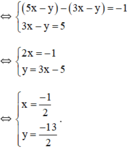
Vậy hệ phương trình có nghiệm duy nhất 
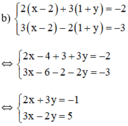
(Nhân hai vế pt 1 với 2; pt 2 với 3 để hệ số của y đối nhau)
 (Hệ số của y đối nhau nên ta cộng từng vế của hai pt)
(Hệ số của y đối nhau nên ta cộng từng vế của hai pt)
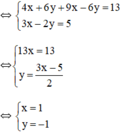
Vậy hệ phương trình có nghiệm duy nhất (1; -1).
Cách 2:
a) Đặt x + y = u và x – y = v (*)
Khi đó hệ phương trình trở thành
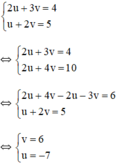
Thay u = -7 và v = 6 vào (*) ta được hệ phương trình:
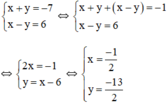
Vậy hệ phương trình có nghiệm 
b) Đặt x – 2 = u và y + 1 = v.
Khi đó hệ phương trình trở thành :
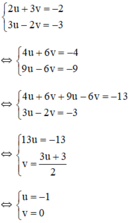
+ u = -1 ⇒ x – 2 = -1 ⇒ x = 1.
+ v = 0 ⇒ y + 1 = 0 ⇒ y = -1.
Vậy hệ phương trình có nghiệm (1; -1).
x 3 + 4 y = y 3 + 16 x 1 + y 2 = 5 ( 1 + x 2 ) ( 1 )
– Xét x = 0, hệ (I) trở thành 4 y = y 3 y 2 = 4 < = > y = ± 2
– Xét x ≠ 0, đặt y x = t < = > y = x t . Hệ (I) trở thành
x 3 + 4 x t = x 3 t 3 + 16 x 1 + x 2 t 2 = 5 ( 1 + x 2 ) < = > x 3 ( t 3 − 1 ) = 4 x t − 16 x x 2 ( t 2 − 5 ) = 4 < = > x 3 ( t 3 − 1 ) = 4 x ( t − 4 ) ( 1 ) 4 = x 2 ( t 2 − 5 ) ( 2 )
Nhân từng vế của (1) và (2), ta được phương trình hệ quả
4 x 3 ( t 3 − 1 ) = 4 x 3 ( t − 4 ) ( t 2 − 5 ) < = > t 3 − 1 = t 3 − 4 t 2 − 5 t + 20 (Do x ≠ 0) <=>4t 2 + 5 t − 21 = 0 < = > t = − 3 t = 7 4
+ Với t = – 3, thay vào (2) được x2 = 1 ⇔ x = ±1.
x = 1 thì y = –3, thử lại (1;–3) là một nghiệm của (I)
x = –1 thì y = 3, thử lại (–1;3) là một nghiệm của (I)
+ Với t = 7/4 , thay vào (2) được x 2 = − 64 31 (loại)
Vậy hệ (I) có các nghiệm (0;2), (0;–2), (1;–3), (–1;3).